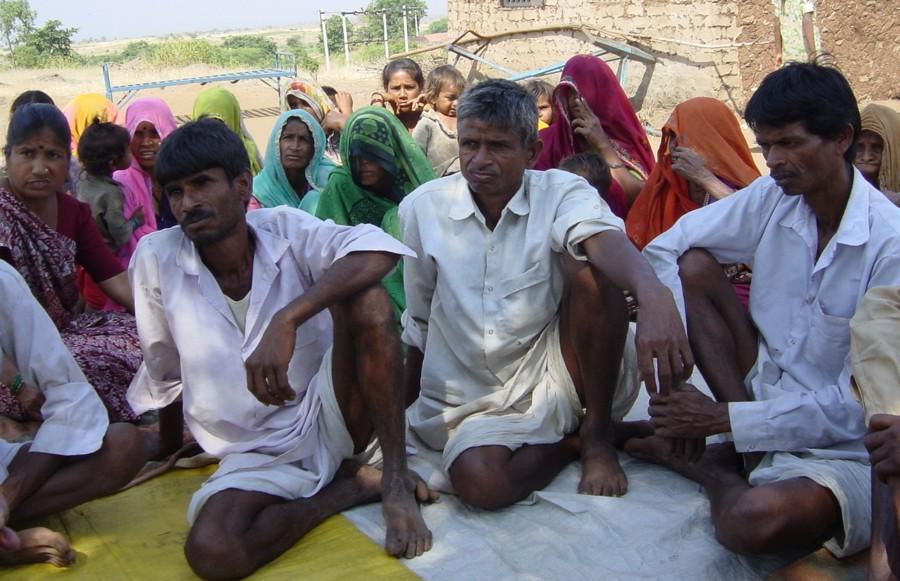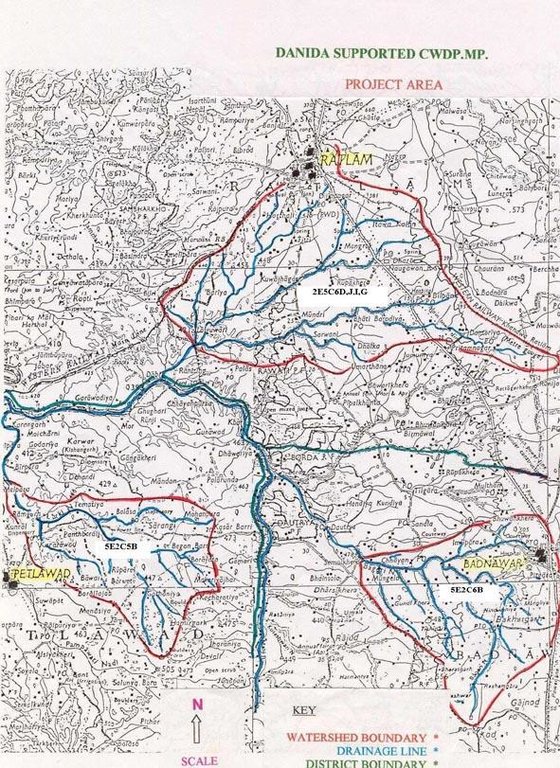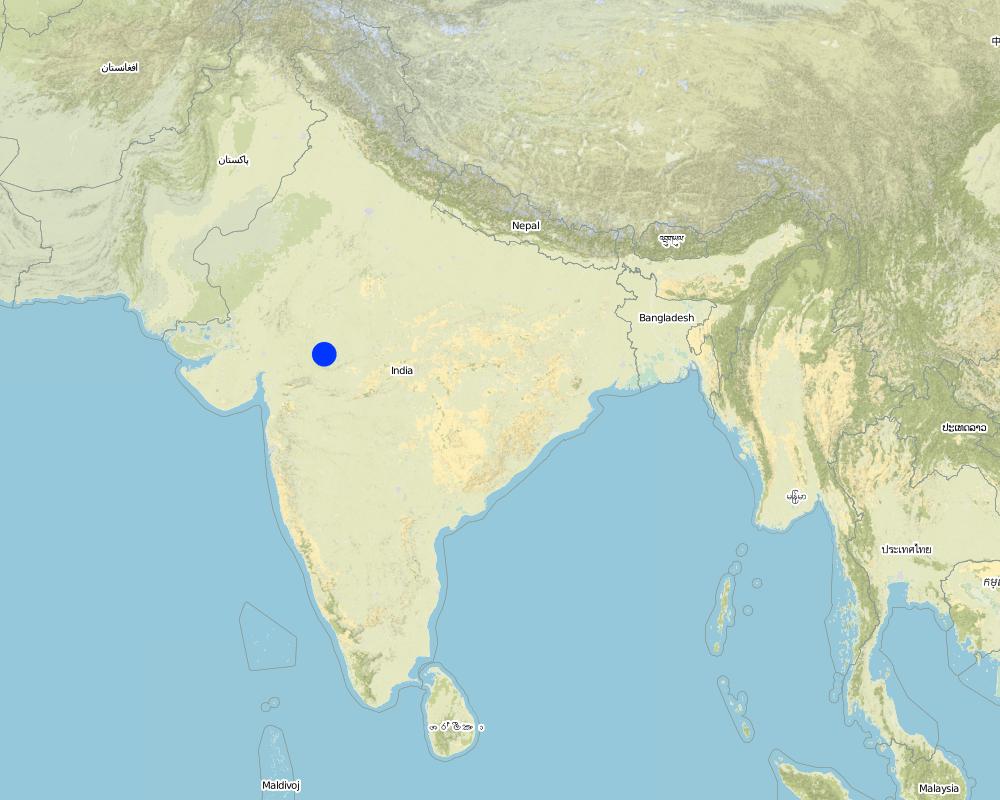Comprehensive watershed development [อินเดีย]
- ผู้สร้างสรรค์:
- การอัพเดท:
- ผู้รวบรวม: David Gandhi
- ผู้เรียบเรียง: –
- ผู้ตรวจสอบ: Fabian Ottiger, Deborah Niggli
approaches_2374 - อินเดีย
ดูส่วนย่อย
ขยายทั้งหมด ย่อทั้งหมด1. ข้อมูลทั่วไป
1.2 รายละเอียดที่ติดต่อได้ของผู้รวบรวมและองค์กรที่เกี่ยวข้องในการประเมินและการจัดเตรียมทำเอกสารของแนวทาง
ผู้เชี่ยวชาญ SLM:
ผู้เชี่ยวชาญ SLM:
ผู้เชี่ยวชาญ SLM:
ผู้เชี่ยวชาญ SLM:
Desai Nilesh
SAMPARK, Raipuria, Tehsil- Petlawad, Distt. Jhabua (MP)
อินเดีย
ผู้เชี่ยวชาญ SLM:
ผู้เชี่ยวชาญ SLM:
ผู้เชี่ยวชาญ SLM:
Bhattacharya Tapan
Lok Biradari Trust, Indore (MP)
อินเดีย
ชื่อของโครงการซึ่งอำนวยความสะดวกในการทำเอกสารหรือการประเมินแนวทาง (ถ้าเกี่ยวข้อง)
Book project: where the land is greener - Case Studies and Analysis of Soil and Water Conservation Initiatives Worldwide (where the land is greener)ชื่อของโครงการซึ่งอำนวยความสะดวกในการทำเอกสารหรือการประเมินแนวทาง (ถ้าเกี่ยวข้อง)
Danida assisted Karnataka Watershed Development Project, Bijapur (Danida assisted Karnataka Watershed Development Project, Bijapur) - อินเดียชื่อของโครงการซึ่งอำนวยความสะดวกในการทำเอกสารหรือการประเมินแนวทาง (ถ้าเกี่ยวข้อง)
Lok Biradari Trust - อินเดีย1.3 เงื่อนไขที่เกี่ยวข้องกับการใช้ข้อมูลที่ได้บันทึกไว้ผ่านทาง WOCAT
ผู้รวบรวมและวิทยากรหลักยอมรับเงื่อนไขเกี่ยวกับการใช้ข้อมูลที่ถูกบันทึกผ่านทาง WOCAT:
ใช่
1.4 การอ้างอิงถึงแบบสอบถามเรื่องเทคโนโลยี SLM
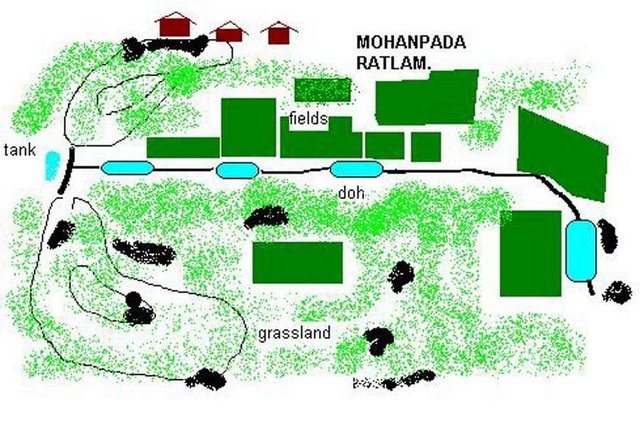
Sunken streambed structure [อินเดีย]
Excavations in streambeds to provide temporary storage of runoff, increasing water yields from shallow wells for supplementary irrigation.
- ผู้รวบรวม: David Gandhi
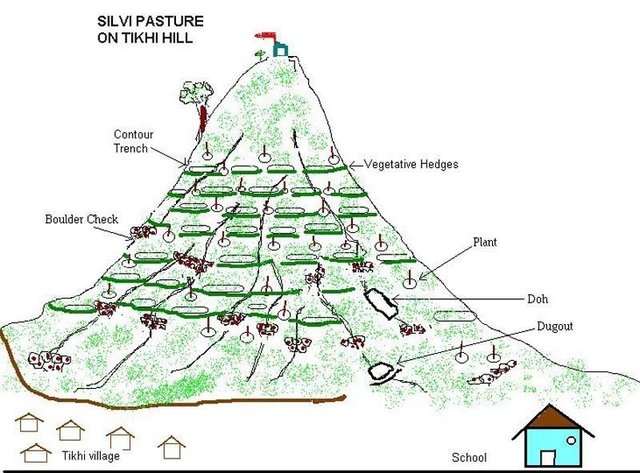
Silvi Pasture [อินเดีย]
Regeneration of degraded hill side using structural, vegetative & managerial measures.
- ผู้รวบรวม: Unknown User
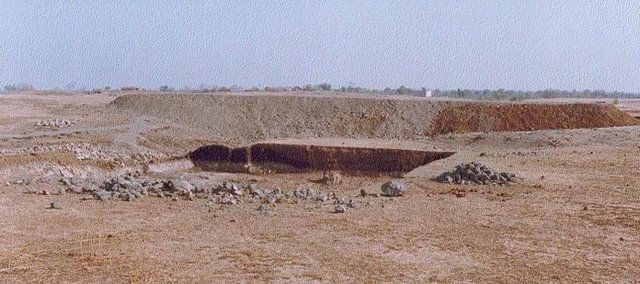
Dugout Pond [อินเดีย]
Dugout pond is a sunken water harvesting structure constructed along the rills in upper catchment for the purpose of storage of runoff and recharge of ground water.
- ผู้รวบรวม: Mulchand Kag
2. คำอธิบายของแนวทาง SLM
2.1 การอธิบายแบบสั้น ๆ ของแนวทาง
Participatory approach that includes a package of measures leading to empowerment of communities to implement and sustain watershed development.
2.2 การอธิบายอย่างละเอียดของแนวทาง
การอธิบายอย่างละเอียดของแนวทาง:
Aims / objectives: The approach adopted under the Comprehensive Watershed Development Project (CWDP) is intended to ensure sustainability of development interventions. This can only be achieved through creating a sense of 'ownership' amongst users, which means involving the community in planning, implementation and management of the interventions. A further, specific objective is to benefit vulnerable sections of the community.
Methods: Various methods are employed to achieve these goals. There is, first of all, awareness generation within the community through exposure visits outside the area, street theatre and video shows. After this comes the formation and capacity building of village level institutions, in particular the Village Watershed Development Committees (VWDCs). Users' groups are also formed. Micro-planning (under a 'village development plan') using participatory rural appraisal (PRA) follows. There are arrangements to ensure participatory execution of the plan, specifying cost and benefit sharing (on average 75%-90% of the work is paid for in cash under this approach). Another important element is to ensure user rights to resources. This entails negotiation with government for rights to produce from common land. Eventually, after initial implementation, management becomes the task of the users' groups: this includes maintenance, distribution of benefits and conflict resolution. The whole process involves NGOs along with government staff in order to achieve better communication all round. The participants have different roles. Government staff (at various levels) provides technical and financial support, as well as assistance towards gaining user rights over resources. NGOs are particularly important in awareness generation and mobilisation, capacity building of village level institutions, and in the process of negotiation with the Government.
Role of stakeholders: The village committee is central in planning and implementation of the village development plan, and in overseeing users's groups. Users's groups are involved in planning, implementation and then resource management. The village assembly helps to identify beneficiaries and users, and to give overall support to the VWDC. An external international donor, DANIDA of Denmark, supports the Comprehensive Watershed Development Project.
2.3 รูปภาพของแนวทาง
2.5 ประเทศ ภูมิภาค หรือสถานที่ตั้งที่ได้นำแนวทางไปใช้
ประเทศ:
อินเดีย
ภูมิภาค/รัฐ/จังหวัด: :
Madhya Pradesh
Map
×2.6 วันที่เริ่มต้นและสิ้นสุดของแนวทาง
ระบุปีที่เริ่ม:
1997
การสิ้นสุดลง (ถ้าแนวทางไม่ได้ใช้อีกต่อไป):
2007
2.7 ประเภทของแนวทาง
- ใช้โครงงานหรือแผนงานเป็นฐาน
2.8 เป้าหมายหรือวัตถุประสงค์หลักของแนวทาง
The Approach focused mainly on SLM with other activities (1- Capacity building of communities, 2- Production system)
- create a sense of ownership amongst users. - ensure sustainability of technical and social interventions. - benefit more vulnerable sections of the community, including the poor and women. - involve the community in planning, implementation and management interventions
The SLM Approach addressed the following problems: previous lack of consultation/involvement with the community in planning, implementation and management of watershed development interventions
2.9 เงื่อนไขที่เอื้ออำนวยหรือเป็นอุปสรรคต่อการนำเทคโนโลยีภายใต้แนวทางนี้ไปปฏิบัติใช้
บรรทัดฐานและค่านิยมทางสังคม วัฒนธรรม ศาสนา
- เป็นอุปสรรค
Lack of awareness and mobilisationon improvement of production systems.
Treatment through the SLM Approach: Intensive programme for awareness generation and mobilisation of community
การมีไว้ให้หรือการเข้าถึงแหล่งการเงินและบริการ
- เป็นอุปสรรค
Treatment through the SLM Approach:
การจัดตั้งระดับองค์กร
- เป็นอุปสรรค
Lack of effective institutions at village level to take responsibility for the development process.
Treatment through the SLM Approach: Formation & capacity building of VLI (VWDC,UG) with assistance of NGOs.
กรอบแนวทางในการดำเนินการด้านกฎหมาย (การถือครองที่ดิน สิทธิในการใช้ที่ดินและน้ำ)
- เป็นอุปสรรค
Uncertainity fover rights to access to resources
Treatment through the SLM Approach: Negotiations facilitated by NGOs
The existing land ownership, land use rights / water rights moderately hindered the approach implementation While treatment of privately owned land did not face a problem, encroachment on Govt. land was an obstacle which discouraged land users from implementing SWC on these lands. Furthermore it was not possible to obtain users rights on lands under the Forest Department, which resulted in their exclusion from SWC in most cases. The NGOs involved however acted as intermediaries in negotiations.
ความรู้เกี่ยวกับ SLM การเข้าถึงการสนับสนุนด้านเทคนิค
- เป็นอุปสรรค
High cost water harvesting measures.
Treatment through the SLM Approach: Demonstration of low cost alternatives such as the doh (sunken structure in dry riverbed to increase infiltration of runoff, which replenishes wells for irrigation: see 'related technology').
3. การมีส่วนร่วมและบทบาทของผู้มีส่วนได้ส่วนเสียที่เกี่ยวข้อง
3.1 ผู้มีส่วนได้ส่วนเสียที่เกี่ยวข้องในแนวทางนี้และบทบาท
- ผู้ใช้ที่ดินระดับท้องถิ่นหรือชุมชนระดับท้องถิ่น
Specific ethnic groups: While the main group were Bhil tribal, other groups included Gujars, Patidars etc.
Due to social factors, traditionally decision making largely done by men. However, the project has worked towards involving women in all aspects of the project. Participation of women in decision making bodies such as village committee is restricted . Participation of women is good in implementation, self-help groups etc. The project is active in neediest & most degraded villages which are fairly homogenous in nature. Furtherore efforts are made to identify and benefit poorest households.
- องค์กรพัฒนาเอกชน
- รัฐบาลระดับท้องถิ่น
Village Watershed Development Committee, Users Group.
- รัฐบาลแห่งชาติ (ผู้วางแผน ผู้ทำการตัดสินใจ)
Govt. of India/ Govt. of Madhya Pradesh, Department of Agriculture.
- องค์การระหว่างประเทศ
Danida
ถ้ามีผู้มีส่วนได้ส่วนเสียหลายคนที่เกี่ยวข้องให้ระบุหน่วยงานตัวแทน:
The broad approach was developed by national and international specialists at the time of project appraisal. The detailed pedagogy was developed by the project in consultation with NGO partners and consultants.
3.2 การเกี่ยวข้องของผู้ใช้ที่ดินระดับท้องถิ่นหรือชุมชนระดับท้องถิ่นในช่วงต่างๆของแนวทาง
| ความเกี่ยวข้องของผู้ใช้ที่ดินระดับท้องถิ่นหรือชุมชนระดับท้องถิ่น | ระบุผู้ที่มีส่วนเกี่ยวข้องและอธิบายกิจกรรม | |
|---|---|---|
| การริเริ่มหรือการจูงใจ | ปฏิสัมพันธ์ | Mainly:public meetings; partly: awareness generation; Community meeting for discussion. Street plays, exposure visits for awareness generation. |
| การวางแผน | ปฏิสัมพันธ์ | Mainly: rapid/participatory rural appraisal; partly: group meeting; Preparation of village plan. Discussion on village plan. Negotiation, Decision making. |
| การดำเนินการ | ปฏิสัมพันธ์ | responsibility for minor steps; Landusers provide labour, partly subsidized by project. VWDC members involved in supervision & payments. |
| การติดตามตรวจสอบหรือการประเมินผล | ปฏิสัมพันธ์ | measurements/observations; Water levels, migration rates monitored by community with project staff. Gram sabha (Village assembly) meets every 3-6 months to discuss project activity. VWDC meets monthly to take stock. |
| Research | ไม่ลงมือ | on-farm; studies carried out by project staff. |
3.3 แผนผังแสดงขั้นตอนการทำงาน (ถ้ามี)
คำอธิบาย:
CWDP-MP: Comprehensive Watershed Development Project in Madhya Pradesh PIP: Project Implementation Plan VWDC: Village Watershed Development Committee
3.4 การตัดสินใจเลือกใช้เทคโนโลยี SLM
ระบุผู้ที่ทำการตัดสินใจเลือกเทคโนโลยีมากกว่าหนึ่งวิธีไปปฏิบัติใช้:
- ผู้เชี่ยวชาญ SLM เป็นผู้ตัดสินใจหลัก ที่ติดตามให้คำปรึกษากับผู้ใช้ที่ดิน
การอธิบาย:
exposure visits' to outside demonstration sites are used as a tool for sensitisation, motivation and awareness raising.
Decisions on the method of implementing the SLM Technology were made by mainly by land users supported by SLM specialists. Discussion with VWDC,UG.
4. การสนับสนุนด้านเทคนิค การสร้างขีดความสามารถ และการจัดการด้านความรู้
4.1 การสร้างขีดความสามารถ / การอบรม
ได้มีการจัดอบรมให้แก่ผู้ใช้ที่ดินหรือผู้มีส่วนได้ส่วนเสียคนอื่น ๆ หรือไม่:
ใช่
ให้ระบุว่าใครเป็นผู้ได้รับการอบรม:
- ผู้ใช้ที่ดิน
- SWC specialists, extensionists/trainers
รูปแบบการอบรม:
- กำลังดำเนินการ
- จัดคอร์ส
รูปแบบการอบรม:
- exposure visits
หัวข้อที่พูด:
1- Training for VWDC, UG, SHG's to conduct meetings, accounts and book-keeping. 2- Technical trainings. These are provided by government and NGO staff. Training concentrates on participatory approaches and low cost technologies. Capacity building for community groups and land users enables them to participate better in projects and to take ownership of assets.
4.2 การบริการให้คำแนะนำ
ผู้ใช้ที่ดินมีการเข้าถึงการรับบริการให้คำปรึกษาหรือไม่:
ใช่
ระบุว่ามีบริการให้คำปรึกษาหรือไม่:
- ไปเยี่ยมชมสถานที่
การอธิบาย/แสดงความคิดเห็น:
Name of method used for advisory service: Multi Disciplinary Teams; Key elements: Field staff drawn from different Govt. line deptt. and NGO's., Village level workers selected locally, paid by the Project through NGOs., Formation, capacity building of village level institutions and farmers.; 1) Advisory service carried out through: non-governmental agency, projects own extension structure and agents; Extension staff: Govt.+ NGO employees 2) Target groups for extension: land users; Activities: Capacity building of village institutions, demonstration of SWC measures, production
Advisory service is quite adequate to ensure the continuation of land conservation activities; The state policies now emphasise the participatory approach. However, aspects like GO-NGO cooperation need to be instutionalised.
4.3 การเสริมความแข็งแกร่งให้กับสถาบัน (การพัฒนาองค์กร)
สถาบันได้รับการจัดตั้งขึ้นมาหรือเสริมความแข็งแกร่งโดยแนวทางนี้หรือไม่:
- ใช่ อย่างมาก
ระบุระดับของสถาบันที่ได้รับการเสริมความแข็งแกร่งหรือจัดตั้งขึ้นมา:
- ท้องถิ่น
ระบุประเภทของการให้ความช่วยเหลือสนับสนุน:
- ด้านการเงิน
- การสร้างขีดความสามารถ / การอบรม
4.4 การติดตามตรวจสอบและประเมินผล
การติดตามตรวจสอบและประเมินผลเป็นส่วนหนึ่งของแนวทางหรือไม่:
ใช่
ความคิดเห็น:
bio-physical aspects were regular monitored through observations; indicators: general parameters
technical aspects were regular monitored through measurements; indicators: water levels in some wells
socio-cultural aspects were ad hoc monitored through measurements; indicators: migration
economic / production aspects were regular monitored through measurements; indicators: yield
area treated aspects were ad hoc monitored through observations; indicators: hectares treated
no. of land users involved aspects were regular monitored through measurements; indicators: attendance at meetings
There were several changes in the Approach as a result of monitoring and evaluation: Several technological changes have taken place as a result of a review: for example feedback on yield data led to crop variety recommendations. Levels of water in wells confirmed impact of the 'sunken structures' (dohs).
5. การสนับสนุนด้านการเงินและวัสดุอุปกรณ์
5.1 ระบุงบประมาณประจำปีสำหรับแนวทาง SLM นี้
ถ้าหากว่างบประมาณประจำปีไม่เป็นที่ทราบแน่นอน ให้ระบุช่วงลงไป:
- 10,000-100,000
แสดงความคิดเห็น (แหล่งของการระดมทุน ผู้บริจาคคนสำคัญ):
Approach costs were met by the following donors: government (national): 5.0%; international (-): 85.0%; local community / land user(s) (labour): 10.0%
5.2 การสนับสนุนด้านการเงิน / วัสดุอุปกรณ์ให้แก่ผู้ใช้ที่ดิน
ผู้ใช้ที่ดินได้รับการสนับสนุนด้านการเงิน / วัสดุอุปกรณ์ไปปฏิบัติใช้เทคโนโลยีหรือไม่:
ใช่
5.3 เงินสนับสนุนสำหรับปัจจัยนำเข้า (รวมถึงแรงงาน)
- อุปกรณ์
| ระบุปัจจัยนำเข้าที่ได้รับการสนับสนุน | เห็นด้วยระดับไหน | ระบุเงินสนับสนุน |
|---|---|---|
| เครื่องจักร | ได้รับการช่วยเหลือทางการเงินแบบเต็ม | |
- การเกษตร
| ระบุปัจจัยนำเข้าที่ได้รับการสนับสนุน | เห็นด้วยระดับไหน | ระบุเงินสนับสนุน |
|---|---|---|
| เมล็ด | ได้รับการช่วยเหลือทางการเงินบางส่วน | |
| Seedlings | ได้รับการช่วยเหลือทางการเงินบางส่วน | |
ถ้าแรงงานโดยผู้ใช้ที่ดินเป็นปัจจัยนำเข้าที่มีอยู่มากมาย ระบุด้วยว่าเนื่องจาก:
- จ่ายเป็นเงินสด
ความคิดเห็น:
As is common in Indian watershed development initiatives, there is a substantial subsidy towards labour involved. under this approach 75-90% of labour input is paid for in terms of cash: the remainder is voluntary contribution
5.4 เครดิต
มีการจัดหาเครดิตมาให้ภายใต้แนวทาง SLM หรือไม่:
ไม่ใช่
6. การวิเคราะห์ผลกระทบและการสรุป
6.1 ผลกระทบของแนวทาง
ช่วยให้ผู้ใช้ที่ดินนำเอาเทคโนโลยี SLMไปใช้และบำรุงรักษาสภาพไว้ได้หรือไม่:
- ไม่ใช่
- ใช่ เล็กน้อย
- ใช่ ปานกลาง
- ใช่ อย่างมาก
The participatory approach has been fairly successful in demonstrating SWC technologies such as Silvi Pasture, Sunken Structures which have been adopted/maintained by the land users.
ปรับปรุงประเด็นของการถือครองที่ดินหรือสิทธิในการใช้ ซึ่งขัดขวางการนำเทคโนโลยีไปใช้ให้ดีขึ้น:
- ไม่ใช่
- ใช่ เล็กน้อย
- ใช่ ปานกลาง
- ใช่ อย่างมาก
By using the approach, the project was able to win the confidence of most land users.
Did other land users / projects adopt the Approach?
- ไม่ใช่
- ใช่ เล็กน้อย
- ใช่ ปานกลาง
- ใช่ อย่างมาก
The pilot project which has tested the approach over past 3-4 years is implemented by the Department of Agriculture. The State Department of Agriculture has now expanded the approach to its other projects eg. NWDPRA.
6.3 ความยั่งยืนของกิจกรรมของแนวทาง
ผู้ใช้ที่ดินสามารถทำให้สิ่งต่างๆ ที่ได้ปฏิบัติใช้โดยแนวทางนี้ยั่งยืนได้หรือไม่ (โดยไม่มีการสนับสนุนจากภายนอก):
- ไม่แน่ใจ
ถ้าตอบว่าไม่หรือไม่แน่ใจ ให้ระบุและแสดงความคิดเห็น :
1- NGO's will contrinue to visit villages where project has completed bio-physical activities for a period of 2-3 years with a view to provide support and further training to VLI's & communities. Hence it is pre-mature to comment at this stage.
6.4 จุดแข็งและข้อได้เปรียบของแนวทาง
| จุดแข็ง / ข้อได้เปรียบของแนวทางในทัศนคติของผู้ใช้ที่ดิน |
|---|
| Awareness about SWC increased through street plays, exposure visits. Use of drama preferred to verbal communication. (How to sustain/ enhance this strength: Continue, and include visits to successful income generating projects.) |
| Participatory planning has led to better understanding of resources and possibilities (How to sustain/ enhance this strength: The entire village plan should be implemented in defined stages to allow impact to be noted/felt.) |
| Cost-sharing increases feeling of ownership. (How to sustain/ enhance this strength: Community contribution should be deposited in the village fund to enable further activities after project moves out.) |
| Due to village institutions, there is greater decentralisation of ressponsibility and more people are actively involved. |
| As a result of village fund, interest component remains within the village. |
| Increased transparency as a result of GO-NGO cooperation. (How to sustain/ enhance this strength: Less rigidity in roles of GO/NGO staff.) |
| จุดแข็ง / ข้อได้เปรียบของแนวทางในทัศนคติของผู้รวบรวมหรือวิทยากรหลัก |
|---|
| Marginalised groups have been identified and given a 'say' (How to sustain/ enhance this strength: NGOs should continue to advise/guide/monitor activities) |
| Systematic approach to strengthen community participation (How to sustain/ enhance this strength: Detailed 'process documentation' to be continued.) |
| Leadership developed at village level. (How to sustain/ enhance this strength: NGO's continue to advise/guide/monitor activities in the village.) |
| Land users develop a strong sense of ownership of the assets created. (in terms of cost-sharing, a local contribution of up to 25% is high in Indian contexts) (How to sustain/ enhance this strength: There needs to be continued support for 2-3 years after phasing out of bio-physical watershed development activities; also important to build up village funds through a 'community contribution' charge deducted from wages.) |
| Government system can be strengthened by co-operation with NGOs in watershed management projects (How to sustain/ enhance this strength: Continue dialogue between partners at various levels..) |
6.5 จุดอ่อน / ข้อเสียเปรียบของแนวทางและวิธีในการแก้ไข
| จุดอ่อน / ข้อเสียเปรียบในทัศนคติของผู้ใช้ที่ดิน | สามารถแก้ไขปัญหาได้อย่างไร |
|---|---|
| Formation of User group creates conflict with surrounding villages. | |
| Segregation of responsibilities of GO-NGO staff viz. NGO role restricted to community organisation while GO staff deal with technical asspects. | Better integrated teamwork should be the goal. |
| A 'community contribution' charge is currently deducted equally from all villagers by the project from wages paid | Contribution to be deposited in village fund., Should be a greater voluntary contribution from the richer farmers. |
| Participation in various meetings at village level is cumbersome for women, resulting in increased pressure from male family members and loss of wages. | |
| Project duration for planning and implementation too short | Increase the timespan to 3 years or more. |
| Women not adequately involved in exposure visits. | Correct this imbalance/arrange separate visits for women. |
| Exploitation by middlemen when small farmers market produce not addressed by the project. | Group marketing of produce. |
| จุดอ่อน / ข้อเสียเปรียบในทัศนคติของผู้รวบรวมหรือวิทยากรหลัก | สามารถแก้ไขปัญหาได้อย่างไร |
|---|---|
| Because of low literacy levels NGO support to village level institutions is required for more than just short-term | Adult literacy classes of sufficient duration are needed. |
| PRA brings out many social factors that are beyond the scope of the project to influence eg the feudal system | NGOs need to have broadbased activity platforms that can address these issues as they arise. |
| Shortage of female staff restricts contact with women land users. | Gender sensitization, training for project staff intensified. |
7. การอ้างอิงและการเชื่อมต่อ
7.1 วิธีการหรือแหล่งข้อมูล
- ไปเยี่ยมชมภาคสนาม การสำรวจพื้นที่ภาคสนาม
- การสัมภาษณ์กับผู้ใช้ที่ดิน
7.2 การอ้างอิงถึงสิ่งตีพิมพ์
ชื่อเรื่อง ผู้เขียน ปี ISBN:
'Participatory approaches in watershed management- successful experinces' David Gandhi 2002
ช่องทางในการสืบค้น และราคา:
Indian Association of Soil Conservation, Central Soil & Water Conservation Research & Training Insti
ลิงก์และโมดูล
ขยายทั้งหมด ย่อทั้งหมดลิงก์

Sunken streambed structure [อินเดีย]
Excavations in streambeds to provide temporary storage of runoff, increasing water yields from shallow wells for supplementary irrigation.
- ผู้รวบรวม: David Gandhi

Silvi Pasture [อินเดีย]
Regeneration of degraded hill side using structural, vegetative & managerial measures.
- ผู้รวบรวม: Unknown User

Dugout Pond [อินเดีย]
Dugout pond is a sunken water harvesting structure constructed along the rills in upper catchment for the purpose of storage of runoff and recharge of ground water.
- ผู้รวบรวม: Mulchand Kag
โมดูล
ไม่มีโมดูล


